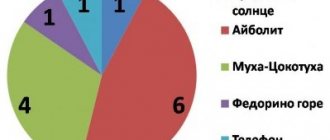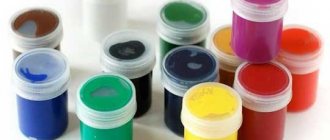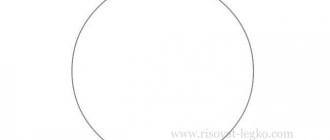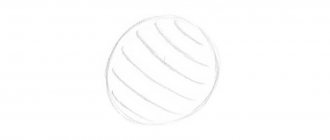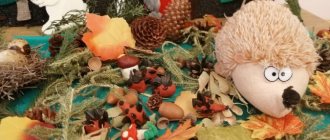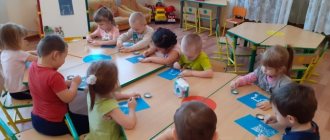Summary of a lesson on application on the topic “Dishes” in kindergarten
- April 2, 2021
International and All-Russian competitions
Laureate of the All-Russian competition of pedagogical excellence “Methodological piggy bank of a kindergarten teacher”
Summary of a lesson in the second junior group of kindergarten on the topic “Utensils.”
Goal: To reinforce the names of utensils with children.
Tasks:
- Develop memory, attention, speech of children.
- Activate the dictionary on the topic: “Dishes”.
- Develop the ability to coordinate words in a sentence.
- To develop skills of cultural communication, hospitality, and friendliness.
GCD move
Educator: Guys, hello.
(There is a knock on the door. Winnie the Pooh enters the group and cries).
Educator: Good afternoon, Winnie the Pooh. What's happened? Why are you crying?
Winnie the Pooh. Good afternoon guys. How can I not cry? Today is my birthday. Eeyore, Piglet, Owl and Rabbit will come to visit me in the evening, and I have completely forgotten how to greet guests. Also, I don’t have any mugs in my house, because I broke the last mug this morning.
Educator: Winnie the Pooh, don’t be upset. The guys and I will definitely help you. Really, guys?
Children: Yes.
Educator: Guys, who knows what they usually treat guests to at birthday parties?
Children: Tea, sweets, cake, fruit.
Educator: Well done. Guys, let's show Winnie the Pooh how to properly set the table.
Children: First you need to cover the table with a beautiful tablecloth (demonstration). Then you should put the sugar bowl. It contains sugar. And this is a napkin holder. Napkins are placed in it to wipe your hands. And this is a candy bowl. You need to put candy in it.
Educator: That's right, but fruits can be put in a vase like this. It will look beautiful on the table. Guys, where will Winnie the Pooh put the cake?
Children: The cake can be placed on this spread.
Educator: Everything is correct. And for tea you need teaspoons (demonstrates), a teapot and mugs.
Guys, let's play a little with Winnie the Pooh.
Fizminutka
(Children form a circle. The teacher is in the center of the circle, reads the text and shows the movements that the children repeat) Knock - knock - knock, knock - knock - knock. (They knock their fists against each other.) A loud knocking sound is heard. A loud chime is heard. (They stomp their feet, hands on the belt). Ding-ding - dong, ding - ding - dong. It is in the kitchen that spoons, forks, cups, and ladle are dancing. (Tilt left and right arms with a shelf in front of the chest). Tra-ta-ta, tra-ta-ta All the dishes started dancing! (Perform a “spring”, hands on the belt). Kettle lid here, there! Spoons in a cup - knock, knock! And the pots - boom - boom! Frying pans - don - don! (“Dance”, alternately putting the left and right leg forward on the heel, hands behind the back). That's how the dance is - beauty! Tra-ta-ta, tra-ta-ta! (Clap their hands.)
Educator: Guys, did you like playing?
Children: Yes.
Winnie the Pooh: And I really liked it.
Educator: Guys, now I propose to make multi-colored mugs for Winnie the Pooh and his guests.
Children go to the tables. In front of each of them lies a ready-made mug made of colored cardboard. There are multi-colored circles on a plate. Children take a circle, smear it with a glue stick and place it on the circle in any order. Each child must glue 3 to 5 circles. The teacher and Winnie the Pooh help the children when they have difficulty.
At the end of the work, Winnie the Pooh and the teacher praise the children. Each child says what color his mug is and what color he pasted the circles (if the child has difficulty, other children help).
The teacher invites the children to give their mugs to Winnie the Pooh. Children are happy to give. Winnie the Pooh says “Thank you” and gives the children balloons. Children congratulate Winnie the Pooh on his birthday and sing “Loaf” to him. Winnie the Pooh says goodbye and leaves.
Educator:
- Guys, who came to visit us today?
- What happened to Winnie the Pooh?
- How did we help him?
- How did we congratulate the bear cub? What did he give us?
- What did you like most?
The work was presented by teacher Maria Aleksandrovna Druzhkova.
Didactic game "Dishes"
Didactic game “Number. Sign. Subject" on the lexical topic "Utensils"
The game is intended for children aged 4-6 years with severe speech impairments, as well as for children of preschool and primary school age to develop the lexical and grammatical structure of speech.
Didactic game “Number. Sign. Subject" can be used both in individual and subgroup lessons with children.
Target:
This set of games will help an adult teach a child:
- agree nouns with numerals and adjectives in gender, number, case,
- select qualitative, relative, possessive adjectives for nouns,
- use ordinal numbers in speech, coordinate them with nouns and adjectives in gender, number, case,
- activate mental activity, associative thinking,
- make comparative sentences with the conjunction “a”.
Material for the game:
cards with game tasks in two subjects of the same lexical group, a playing field and cut cards for independent selection and compilation of a plot series, sets of numbers.
Game description:
Game with ready-made models : each table contains tasks for two subjects of the same lexical group for a larger educational load. At the beginning of the game, the child needs to be clearly shown how associations can be used to indicate the characteristics of objects. For example, how can you depict a bitter taste, show the hardness, softness, juiciness of vegetables, color and shape.
Below are ready-made game cards:
- one porcelain deep plate,
- three shiny metal pans,
- two tall shiny glasses,
- five wooden large spoons,
- four sharp metal knives,
- six plastic red bowls,
- one birch bark yellow bread box,
- seven porcelain birch bark cups.
The game requires compliance with the following steps:
- Name a word denoting a number (what number? four).
- Name the word denoting the object (what is it? - knife).
- Agree the noun with the numeral in gender (how many knives? four knives).
- Name the words denoting the attribute of an object, coordinate them with numerals and nouns in gender, number (four knives (which ones?) - metal, sharp).
- Agree the numeral with the adjectives and nouns in gender and number. (Say in a complete sentence, starting with the number. – Four sharp metal knives.)
- Using the same principle, consider another object of the lexical group - a bowl.
- Make comparative sentences with the conjunction “a”. (There are four knives, and six bowls. The knife is metal, and the bowl is plastic, etc.)
Game with cut cards : played on the same principle as with ready-made models. Only here the child takes an active position and is given more independence.
First, you should invite the child to choose an item on a lexical topic and place it in a sector with an asterisk, then a number (place in the first sector) and select adjectives in the form of picture symbols (place in the longest sector of the playing field). The symbol pictures are first reviewed and what they mean is explained.
To better understand the progress of the game with cut cards, a sample is provided below.
Using the didactic game Number. Sign. Subject children will quickly master the skills of agreeing adjectives, nouns and numerals in gender, number, case, learn to select adjectives for nouns and develop their associative thinking.
The development of associative thinking has a positive effect on the process of memorizing and reproducing necessary information.
On our website you can find other educational games from the Number series. Sign. Item. To do this, follow the highlighted link .
We wish everyone success.
Abstract of GCD on the surrounding world in the second junior group on the topic “Cookware”
Lesson on the surrounding world in kindergarten.
Second junior group. Topic: Dishes Objectives: 1. Educational:
To develop children’s knowledge about dishes and their purpose.
Teach children to name parts of dishes. Learn to name a general word. 2. Developmental:
To develop children's speech, motor skills of the hands and body, memory, and thinking.
3. Educators:
Instill in children a caring attitude towards surrounding objects.
Equipment and materials: a fragment of a video recording of the cartoon “Fedoreno Grief”, kitchen utensils, cut-out pictures (A4 format) depicting dishes, a “Fedora” costume. 1. Organizational moment. Hello guys!
You are all so beautiful today, you came to kindergarten in a good mood, and in order to maintain your mood until the end of the day, let’s do a little exercise with you. 2. Progress of the lesson:
Fedora : Do you guys recognize me? Who am I? (children's answers). One, two, three, four, (Rhythmic fist bumps and clapping alternately.) We washed the dishes: (One palm slides over the other) A teapot, a cup, a ladle, a spoon And a large ladle. (We bend our fingers one at a time for each name of the dish.) We washed the dishes, (One palm slides over the other.) We only broke the cup, the ladle also fell apart, the nose of the teapot came off, (We bend our fingers again.) We slightly broke the spoon. This is how we helped mom. (Rhythmic fist bumps and clapping alternately.) The teacher brings out the “Fedora” doll. Fedora: You know, my children suffered a great tragedy. Do you want to know which one? (Yes). Let us see what happened? The children, together with Fedora, watch a fragment of the cartoon “Fedorino's grief” (a fragment where the dishes leave the house). Fedora: Tell me guys, what happened to me? (children's answers). Fedora: That’s right, all the dishes ran away from me. Why did the dishes run away? (children's answers) Fedora : That's right, guys, because I didn't wash it. Guys, can you help me get my dishes back? (Yes). Fedora : I completely forgot which dishes ran away. Let's remember together. It lies in this magic box, I will take it out, and you will help me. I puff, puff, I don’t want to get warm anymore. The lid rang loudly: “Drink tea, the water has boiled!” Teapot
Teapot's girlfriend Has two ears, Cooks porridge and soup for Yulia.
And her name is... Saucepan
Carries water to the Master to please;
Lives with him until he falls. Cup
If I'm empty, I don't forget about myself, But when I'm carrying food, I won't pass by my mouth.
Spoon
Among spoons I am a colonel.
And my name is... Ladle
It can be deep.
It can be small. However, this is not a river. The plate
If sharpened well, it cuts everything very easily - Bread, potatoes, beets, meat, Fish, apples and butter.
Knife
Guys, tell Fedora what the pan is for?
(children's answers) What parts does the pan consist of? (children's answers) Fedora: shows the teapot. Why do we need a kettle? (children's answers) What does the teapot have? (children's answers) Fedora: Guys, why do you think we need a cup and a plate? (children's answers) Fedora : Please tell me how to use a ladle? (children's answers). Fedora : Who can tell me what a frying pan is for? (children's answers) Fedora : guys, tell me how to care for the dishes? (children's answers). Fedora: That’s right, dishes should be washed with detergents and cleaned with powder. This is a saucepan. You can cook soup in it. This is a plate. You can put food in it. This is a spoon. You can use a spoon to scoop up food and put it in your mouth. This is a cup. You can pour tea into it and drink it. This is a knife. They can be used to cut bread. This is a frying pan. You can fry cutlets on it. Fedora : Well done guys, and now you and I will turn into dishes. 3. Physical exercise (Children form a circle. The teacher is in the center of the circle, reads the text and shows the movements that the children repeat) Knock - knock - knock, knock - knock - knock. (They knock their fists against each other.) A loud knocking sound is heard. A loud chime is heard. (They stomp their feet, hands on the belt). Ding-ding - dong, ding - ding - dong. It is in the kitchen that spoons, forks, cups, and ladle are dancing. (Tilt left and right arms with a shelf in front of the chest). Tra-ta-ta, tra-ta-ta All the dishes started dancing! (Perform a “spring”, hands on the belt). Kettle lid here, there! Spoons in a cup - knock, knock! And the pots - boom - boom! Frying pans - don - don! (“Dance”, alternately putting the left and right leg forward on the heel, hands behind the back). That's how the dance is - beauty! Tra-ta-ta, tra-ta-ta! (Clap their hands.) Fedora : Thank you children for teaching me how to take care of dishes. Children, look, the dishes have returned to me. Let's see what dishes have returned. 4. Didactic game “Cut-out pictures” Children work in pairs, collecting cut-out pictures. Fedora : Tell me guys, what dishes came back to me? (children name the dishes on the cut-out pictures). Fedora : Goodbye guys, it's time for me to leave. Thank you for helping me return the dishes. Now I will take good care of her. 5. Reflection. Who came to visit us? What games did we play? Children, what did you like most about the lesson? What was difficult to accomplish? List of sources : Nishcheva N.V. Card index of outdoor games, exercises, physical education minutes, finger gymnastics.
We recommend watching:
Synopsis of GCD in the second junior group Synopsis of an open music lesson for children of the 2nd junior group Synopsis of a game lesson on search and research activities with children of the 2nd junior group Synopsis of a lesson in the 2nd junior group
Similar articles:
Summary of lessons in kindergarten in the 2nd junior group. Group room
Summary of a lesson in the junior group of kindergarten on the topic: “Human nutrition”
Lesson notes about kindergarten. Junior group
